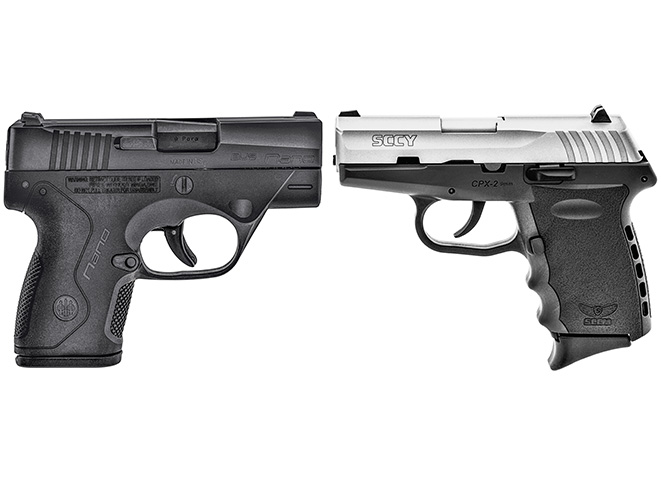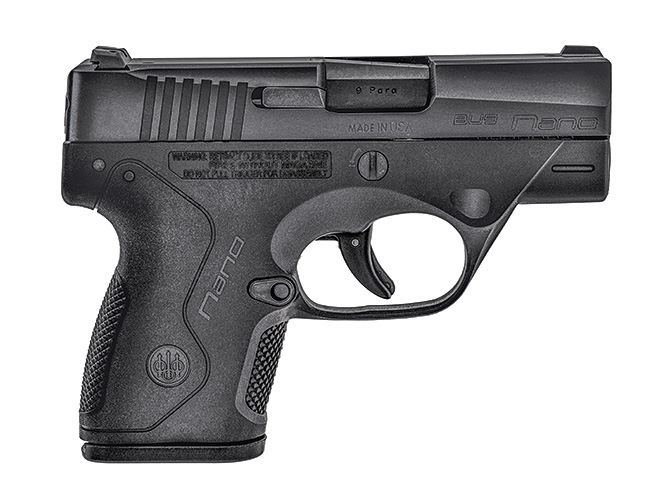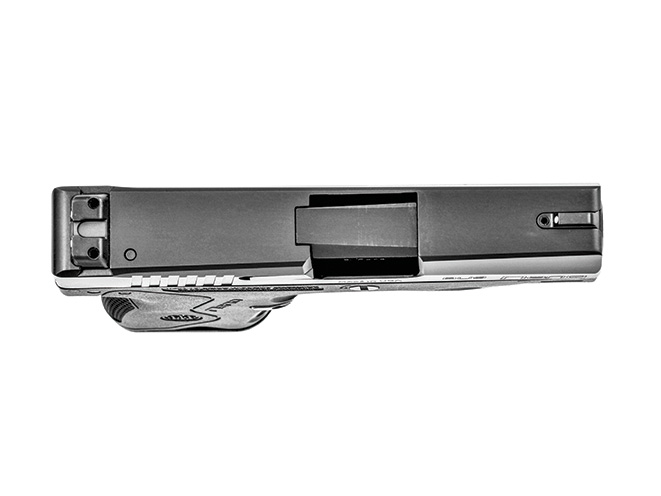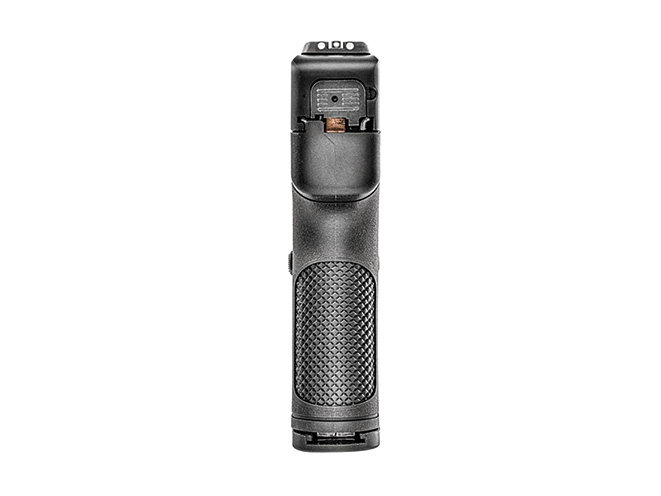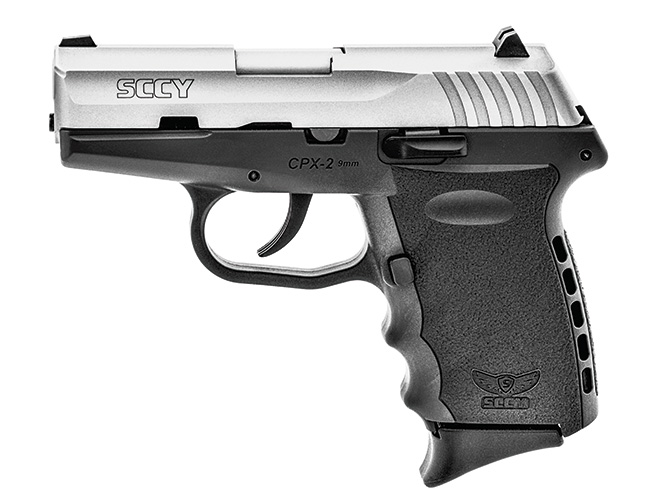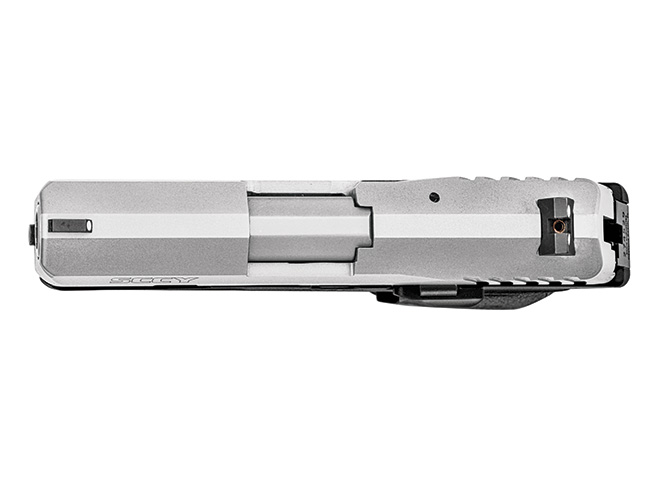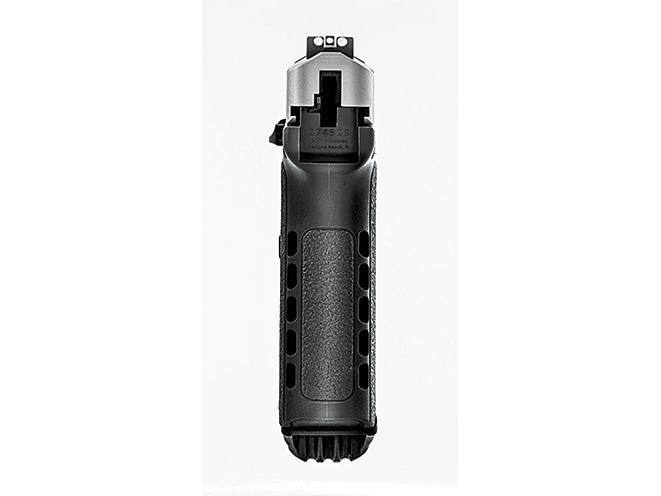Heckler & Koch started it, Glock perfected it and today virtually every arms maker offers some type of polymer-framed handgun. And there’s good reason for that—polymer makes amazing things possible. The SCCY CPX-2 and Beretta Nano 9mm semi-autos are two perfect examples of what polymer can provide in terms of versatility, resilience and cost effectiveness. They also represent two very different approaches to the same end and ideal candidates for this “Tale of the Tape” installment.
Polymer frames allow one very affordable option: color choices. The Beretta Nano has interchangeable frames in a handful of colors that can be interchanged with the handgun’s innovative, removable fire control subchassis, which contains the frame rails, trigger and firing mechanism—the essential elements that comprise the gun. Beretta offers several Nano frame options, including Flat Dark Earth, Ranger Green and pink. The SCCY CPX-2 is offered in a virtual color wheel of more than 20 frame and slide color options, but its frame is not interchangeable.
For this “Tale of the Tape,” I got my hands on Beretta’s standard all-black Nano and a two-tone SCCY CPX-2 with a polished stainless slide and a Sniper Grey frame. Polymer makes the difference for both guns, as both are very affordable. Nano frames are priced at just $39 and there is no extra charge for any color option when purchasing the CPX-2.
Advertisement — Continue Reading Below
Notes On The Nano

The 9mm Beretta Nano has truly subcompact dimensions, measuring 5.63 inches in length, 4.17 inches in height and 0.9 inches in width while maintaining an empty weight of 19.8 ounces. The Nano’s shape is also eye-catching with a rakish angle to the slide that tapers toward the muzzle, making it a natural for quick reholstering. The Nano ideally fits the average hand with a flat baseplate magazine, which places the little finger under the base. With an extended-capacity magazine, the pistol’s height increases to 5 inches and provides a full-hand grip. A large, curved triggerguard makes getting to work a quick affair, even wearing gloves, and there is still ample room for a two-handed hold with plenty of clearance behind the muzzle of the 3-inch barrel.
The Nano is one of the most foolproof and easiest-to-handle subcompact 9mm semi-autos on the market. Fundamentally, the Nano is very straightforward in its design and operation. It’s a striker-fired, short-recoil design combined with a blade trigger safety and an automatic striker block, which eliminates any external controls except for the mag release and trigger. In fact, there isn’t even a slide release, which makes the gun essentially ambidextrous when reloading. Just pull the slide slightly to the rear and let it go.
Advertisement — Continue Reading Below
RELATED STORY: The Next-Gen Beretta Pico
To help mitigate harsh recoil, Beretta uses a double recoil spring—one wound around the guide rod and another around the plunger. The only external indications of the gun’s condition are the action of the automatic striker block, which rises up though an opening in the top of the slide when the trigger is drawn to the rear, and a loaded-chamber indicator. When a round is chambered, the extractor protrudes just slightly outward from the slide. Other than that, the gun has no obvious tells. The trigger position appears the same (fully forward, toggle extended) whether the slide has been cycled or not. The magazine release is also reversible, and the Nano does not use a magazine disconnect. It will discharge a chambered round with the magazine removed. The only drawback to the striker-fired design is that there is no second-strike capability in the event of a misfire. It requires drawing the slide back 0.31 inches to reset the striker.
The Nano has a black Pronox-finished slide fitted with a windage-adjustable, white-dot rear sight that is locked in place by two standard hex-head setscrews. The white-dot front sight is uniquely locked into a horizontal dovetailed channel with a single hex-head setscrew, making both sights easily interchangeable.
Advertisement — Continue Reading Below
To field-strip the Nano, simply clear the gun, point it in a safe direction and pull the trigger. Then use the edge of a shell casing to rotate the takedown screw on the right side of the frame. The slide, barrel, recoil spring and guide-rod assembly can then be pulled forward off the polymer subframe. Reassembly is faster, as the takedown screw automatically resets and locks itself when the slide is replaced. (There is also a recessed striker deactivation button on top of the gun, which can be depressed with a pen point to deactivate the action for field-stripping, rather than pulling the trigger).
Overall, this is about as simple as a semi-auto can get, and the trigger pull is no worse than many DAO revolvers and semi-autos, with an average pull of 8.5 pounds, 0.75 inches of take-up, a crisp break and a quick reset.
SCCY CPX-2
Advertisement — Continue Reading Below

Right out of the box, the CPX-2 has one notable advantage over the Nano—an internal, hammer-fired DAO action with second-strike capability. The gun’s trigger pull averages 9.5 pounds with 1 inch of take-up, a crisp break and zero overtravel. It does, however, take almost a full release of the trigger to reset.
SCCY builds all of its components in-house; there is no outsourcing of parts except for springs. It even builds its own 10-round magazines. Yes, you read that right: 10 rounds. The CPX-2 is a mere 0.07 inches longer and 0.62 inches taller than the Nano, but with a finger extension on the magazine that provides a full-hand grip, and it’s 1.2 inches wide, including the slide-release lever. With an empty weight of 15.5 ounces, it is a hair lighter than the Nano.
RELATED STORY: Quad-Locked & Loaded – The SCCY CPX-3
Advertisement — Continue Reading Below
SCCY was founded in 2003 by Joe Roebuck, SCCY’s CEO and the company’s head of design and engineering. All of the company’s guns are precision built using the very latest CNC machining and inspection technology. Every SCCY pistol is built to tolerances that far exceed its price point, which is what makes this 9mm an interesting counterpoint to the Nano. The Beretta retails for $450 while the CPX-2 has an MSRP of $314 and comes standard with two magazines, dovetailed white-dot sights and a reversible magazine release. The SCCY also field-strips easily by locking the slide back (thus clearing the action), removing the magazine and pulling a single takedown pin. Reassembly is in reverse order.
These two polymer-framed 9mm semi-autos end up with as much in common as not. Neither has a notable size advantage over the other, while the CPX-2 holds a four-round standard-capacity edge. Four is a lot. The Nano requires giving up its modest height advantage to cut that margin by two. The Nano has a 3-inch barrel while the CPX-2 has a 3.1-inch barrel. It all comes down to handing and accuracy.
Range Report
Advertisement — Continue Reading Below
For a baseline comparison test, I selected Sig Sauer’s 115-grain FMJs. The Nano averaged 1,090 fps while the CPX-2 averaged 1,070 fps. From 7 yards, the Nano and CPX-2 created five-shot groups of 1.75 and 1.2 inches, respectively. Though the Nano’s trigger pull is lighter than the CPX-2’s, the latter’s trigger was smoother and has a wider shoe, making it easier to handle overall. The CPX-2 also generates slightly less felt recoil (due in part to the CPX-2’s backstrap design) and is a tad faster to get back on target. The CPX-2’s drawback is its longer reset.
RELATED STORY: Tale of the Tape – SIG P938-22 Target vs. S&W M&P22
The bottom line is that Beretta has 490 years behind its name while SCCY has barely passed its first decade. All the same, for around $135 less than the Nano, the CPX-2 stacks up as equal or superior in just about every category except frame interchangeability. Both are relatively new, thus the question consumer’s need to ask themselves when making the choice between the CPX-2 and the Nano is almost as old as Beretta itself: What’s in a name?
Advertisement — Continue Reading Below
